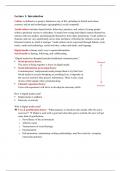Lecture 1: Introduction
Culture is defined as a group’s distinctive way of life, including its beliefs and values,
customs, and art and technologies (geographical, social, temporal).
Youth culture includes shared beliefs, behaviors, practices, and values of young people
within a particular society or subculture. It entails how young individuals express themselves,
interact with one another, and distinguish themselves from older generations. Youth culture is
dynamic and can vary significantly across time and place, reflecting the cultural, social, and
historical context in which it emerges. Youth culture can be expressed through fashion, style,
music, media and technology, social activities, values and ideals, and language.
Digital media is binary and a way to spread information.
Social media is sharing, following, and collaborating.
“Digital media has disrupted/enriched traditional communication.”
Social presence theory: Disrupted
The sense of being together is lower in digital media.
Social information processing theory:
Communicators’ interpersonal needs prompt them to try their best.
Social media is not just disrupting or enriching lives, it depends on
the receiver and how they process information. There is also a lack
of non-verbal signals when communicating.
Channel expansion theory:
Enriched
Users with experience will strive to develop the necessary skills.
How is digital media used?
Replacement or addition
Passively or actively
Why is digital media used?
Uses & gratification theory: “What purposes or functions does media offer for active
receivers?” Media is used with a goal and when that goal is reached, the user will get
some kind of gratification.
o Surveillance of the environment
o Affective need
o Transmission of social heritage
o Entertainment
o Self-promotion, maintaining existing relationships, need for creativity, escapism,
expressing opinions.
,Youth development:
Developmental tasks approach Developmental
tasks/challenges need to be fulfilled.
o Basic idea: Hierarchic list of tasks, met through
biological or social development (= cumulative).
o Applications: Eriksons’s developmental theory.
For a person to adapt, there are developmental
challenges that must be met. Some arise through
biological maturation, others are imposed by families
and society, while others arise from the developing self.
o Media effect example: Effects depend on the
age of the child
Risk and resilience approach Differential life experiences
among children.
o Basic idea: Risk and protective factors explain
differences between children (=cumulative risk model)
o Applications: Snowball effect, turn around models
Bronfenbrenner’s ecological model of development:
Microsystem: How do parents monitor and regulate their
children’s media use? Example: tracking screen time,
keeping media outside of the bedroom).
Exosystem: Is the school offering classes on online
safety and social media policies, such as banning
smartphones from the classroom?
Macrosystem: What do we believe and value regarding
social media? Is it entertainment or dangerous?
Interconnected, but not identical:
Anonymity: different, more extreme forms of behavior Example: cyberbullying.
Creativity: playing around, discovering who you are.
Asynchrony: communication at your convenience, breaking time and space constraints.
Controllability: the ability to decide what information to share or omit.
Identity development: personal, social, gender, ethnic.
Self-presentation:
Front stage: Instagram uploads and profile information. Dramatic interactions. The users'
audience, such as followers and ‘friends’.
Backstage: Instant messaging. Informal talk and a relaxed role.
, Lecture 2: Media effects
Valkenburg & Oliver (2019): “Media use is the intended or incidental use of media channels
(e.g., telephone, email), devices (e.g., smartphone, game console), content/messages (e.g.,
games, narratives, advertising, news), or all types of platforms, tools, or apps (e.g., Facebook,
Instagram, Uber).”
Valkenburg & Oliver (2019): “Media effects are the deliberate and non-deliberate short- and
long-term individual or collective changes in cognitions, emotions, attitudes, and behavior
that result from media use.”
First study into media effects Payne fund studies
Content: what are children exposed to?
Emotional impact?
Behavioral impact?
Conclusion: media has very strong behavioral effects on children.
Legacy of fear (impact is unknown, media are very new).
Magic Bullet/Hypodermic Needle perspective: media has a very strong effect. Media is
going to affect everyone in the same way, you can’t run from it. There is nothing you can do
to stop it.
1940s People’s Choice Study
Longitudinal study
Media didn’t lead to any conversion.
Media did lead to a lot of reinforcement.
Limited Effects perspective.
1945 Decatur Study
Two-step flow of communication





